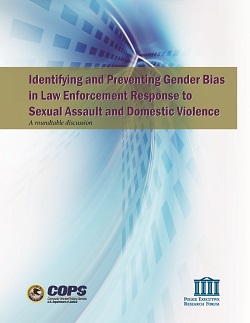In Focus: Hate Crimes
In its 2020 report, the FBI recognized 1,051 victims of hate crimes targeted due to their sexual orientation (13.5% of all hate crimes reported) and 236 victims of hate crimes targeted due to their gender identity (3% of all hate crimes reported). The National Coalition of Anti-Violence Programs (NCAVP) released a report profiling a spike in violence against LGBTQ people during the 2019 Pride season, May-June 2019, showing that people of color and transgender people are disproportionally targeted. NCAVP reported that 91% of all LGBTQ homicide victims were Black, and 64% of homicide victims were Black transgender women. In June 2019, the American Medical Association adopted a policy “to help bring national attention to the epidemic of violence against the transgender community, especially the amplified physical dangers faced by transgender people of color.”
Avoid re-victimizing transgender people who have suffered violence by misgendering them.
Transgender people, particularly transgender women of color, are disproportionately affected by hate violence. The tragedy of these incidents is often compounded by reporting that does not respect (or sometimes even exploits) the fact that the victim is transgender. Often, reporters writing about transgender victims of violent crimes will be given incorrect or incomplete information about a victim’s gender identity (including name and pronouns) from police, from witnesses, or even from family and friends. GLAAD has two special reports to help journalists report fairly and accurately on crimes with transgender victims: Doubly Victimized: Reporting on Transgender Victims of Crime and More Than a Number.
Provide context for the violence.
The transgender community is one of the most marginalized and discriminated against communities in the United States. If a transgender victim was in a difficult or unfortunate situation at the time of a violent crime, provide your audience with context. Please read the U.S. Trans Survey for statistics that will help you provide context about the disproportionate rates of unemployment, poverty, housing instability, and overall discrimination that transgender people face — rates that leave transgender people vulnerable to violence.
Draw attention to this violence.
Media can play a vital role in determining community and law enforcement response to hate crimes. In some cases, local law enforcement still places a low priority on anti-LGBTQ hate crimes. As a result, police may not investigate the case properly or at all, may re-victimize survivors, and may be unresponsive to families and/or community members seeking information. In cases like these, fair, accurate, and inclusive media coverage of the case can motivate law enforcement to better and more transparently investigate and communicate around a hate crime.
Critics of LGBTQ people often downplay or trivialize hate crimes, making statements like “all crimes are hate crimes.” We ask that you offer your audience the facts so they may decide for themselves whether a crime victim was targeted because of their actual or perceived sexual orientation, gender identity, or gender expression.
Assaults and criminal acts may involve only a single victim, but perpetrators often intend to send a message that LGBTQ people are legitimate targets for abuse and violence. (In fact, the victims of some anti-LGBTQ hate crimes are heterosexuals who are perceived to be LGBTQ). Please report the specifics of a crime and its social implications based on the facts of the case.
Inaccurate hate/bias crime reporting can unintentionally support a “gay panic” or “transgender panic” (e.g., “blame the victim”) strategy. Implying that an LGBTQ victim shares responsibility for being attacked, or that an attack was justified because of an unwanted romantic or sexual advance (the so-called “gay panic” or “transgender panic” strategy) is never acceptable.
In August 2013, the American Bar Association issued the following statement: “[T]he American Bar Association urges federal, state, local and territorial governments to take legislative action to curtail the availability and effectiveness of the so-called “gay panic” and “trans panic” defenses, which seek to partially or completely excuse crimes such as murder and assault on the grounds that the victim’s sexual orientation or gender identity is to blame for the defendant’s violent reaction.” As of February 2022, 16 states have banned the “LGBTQ panic” defense, and a dozen more have introduced legislation that would ban it.
Pulse nightclub shooting
In June 2016, a shooter opened fire at Pulse, an LGBTQ nightclub in Orlando, Florida, killing 49 people — most of whom were LGBTQ Latinx people — and wounding 53 others. The attack marked the largest mass shooting in U.S. history and was described by President Barack Obama as both “an act of terror and an act of hate.” The attack also marked the country’s largest mass casualty event specifically targeting LGBTQ people. In June 2021, President Joe Biden signed a bill into law designating the Pulse site as the National Pulse Memorial.
Hate crimes laws and their limitations
The Matthew Shepard and James Byrd, Jr. Hate Crimes Prevention Act of 2009 added sexual orientation, gender, gender identity, and disability to the categories covered under federal hate crimes law. As a result, federal hate crimes law now addresses violent crimes based on a victim’s race, color, religion, national origin, gender, disability, sexual orientation, and/or gender identity.
State laws on hate crimes vary considerably. As of July 2021, 22 states and Washington, D.C., had hate crime laws that enumerate sexual orientation and gender identity. Eleven states, including Florida, only enumerate sexual orientation in their law. Thirteen states have hate crime laws that are not LGBTQ inclusive, and four states have no hate crimes law at all.
While hate crime laws serve an important purpose in acknowledging and responding to hate violence, these laws have clear limitations, ranging from flaws in data collection and responding to hate violence only after it has occurred, to the challenges in using a biased criminal justice system to address bias. Increasingly, LGBTQ people and other communities disproportionately impacted by hate violence are calling for broader, more holistic responses — such as investing in the communities most harmed by hate violence, working to reduce vulnerability to violence, and addressing the root causes of violence and hate itself.
Organizations:
Please reach out to the below organizations — or GLAAD (press@glaad.org) — to learn more and connect with spokespeople:


